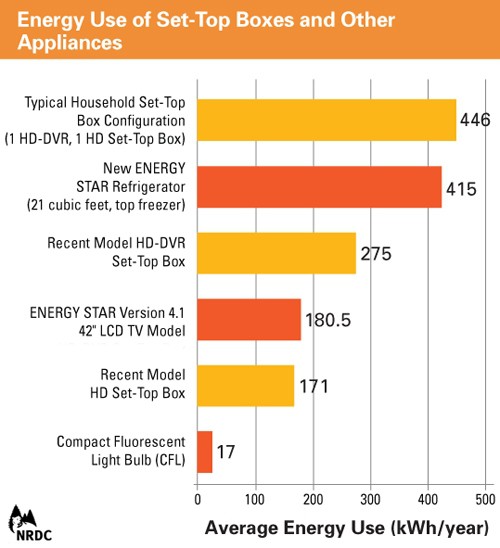 Two years after energy conservation groups revealed many television set-top boxes use almost as much electricity as a typical refrigerator, a voluntary agreement has been reached to cut the energy use of the devices 10-45 percent by 2017.
Two years after energy conservation groups revealed many television set-top boxes use almost as much electricity as a typical refrigerator, a voluntary agreement has been reached to cut the energy use of the devices 10-45 percent by 2017.
The Department of Energy, the Natural Resources Defense Council, the American Council for an Energy-Efficient Economy, the Appliance Standards Awareness Project, the Consumer Electronics Association, and the National Cable & Telecommunications Association agreed to new energy efficiency standards for cable boxes expected to save more than $1 billion in electricity annually, once the new equipment is widely deployed in American homes. That represents enough energy to power 700,000 homes and cut five million tons of CO2 emissions each year.
“These energy efficiency standards reflect a collaborative approach among the Energy Department, the pay-TV industry and energy efficiency groups – building on more than three decades of common-sense efficiency standards that are saving American families and businesses hundreds of billions of dollars,” said Energy Secretary Ernest Moniz. “The set-top box efficiency standards will save families money by saving energy, while delivering high quality appliances for consumers that keep pace with technological innovation.”
DVR boxes are the biggest culprits. American DVRs typically use up to 50W regardless of whether someone is watching the TV or not. Most contain hard drives that are either powered on continuously or are shifted into an idle state that does more to protect the life of the drive than cut a consumer’s energy bill. A combination of a DVR and an extra HD set-top box together consume more electricity than an ENERGY STAR-qualified refrigerator-freezer, even when using the remote control to switch the boxes off.

Manufacturers were never pressed to produce more energy-efficient equipment by the cable and satellite television industry. Current generation boxes often require lengthy start-up cycles to configure channel lineups, load channel listings, receive authorization data and update software. As a result, any overnight power-down would inconvenience customers the following morning — waiting up to five or more minutes to begin watching television as equipment was switched back on. As a compromise, many cable operators instruct their DVR boxes to power down internal hard drives when not recording or playing back programming, minimizing subscriber inconvenience, but also the possible power savings.
In Europe, many set-top boxes are configured with three levels of power consumption — 22.5W while in use, 13.2W while in standby, and 0.65W when in “Deep Sleep” mode. More data is stored in non-volatile memory within the box, meaning channel data, program listings, and authorization information need not be re-downloaded each time the box is powered on, resulting in much faster recovery from power-saving modes.
The new agreement, which runs through 2017, covers all types of set-top boxes from pay-TV providers, including cable, satellite and telephone companies. The agreement also requires the pay-TV industry to publicly report model-specific set-top box energy use and requires an annual audit of service providers by an independent auditor to make sure boxes are performing at the efficiency levels specified in the agreement. The Energy Department also retains its authority to test set-top boxes under the ENERGY STAR verification program, which provides another verification tool to measure the efficiency of set-top boxes.
Comcast, DirecTV, DISH Network, Time Warner Cable, AT&T, Verizon, Cox Communications, Charter Communications, Cablevision, Bright House Networks and CenturyLink will begin deploying new energy-efficient equipment during service calls. Some customers may be able to eventually swap equipment earlier, depending on the company.
[flv]http://www.phillipdampier.com/video/WCCO Minneapolis Check Your Cable Box 6-27-11.mp4[/flv]
WCCO in Minneapolis reported in 2011 cable operators like Comcast may make subscribers wait 30 minutes or more for set-top box features to become fully available for use after plugging the box in. (1:50)


 Subscribe
Subscribe
Bigger power savings are gained by viewing video on smartphones and tablets and storing video on demand in the cloud. Another reason linearTV will become less appealing and practical. The marginal as opposed to average business model will win over the next 10 years on all fronts and all aspects of service provider models. You might want to cite the Berkeley study that points to 97% power savings if the top 3 office apps are moved to the cloud. http://1.usa.gov/1cUrGyW
I’m a bit skeptical of EnergyStar, LEED certification and other such things. Often EnergyStar pushes second-rate technologies (CFL bulbs, vertical-axis washing machines) over first-rate technologies (LEDs, horizontal-axis washing machines.) EnergyStar refrigerators are better than the old ones, but are nothing near the state of the art. As @infostack points out, it makes a lot more sense to go to tablet technology than to try to make small fixes to existing devices. Tablets aren’t energy efficient because the government told them to cut energy use in half, they’re energy efficient because they compete in the market place with attributes that customers… Read more »
What kills me is this has been possible for years. Yet these boxes still suck power. I just built a fairly respectable computer that uses under 15w max. It would use less if I did not have a wireless transmitter in it (3w to be precise another 3 if I had 1 stick of memory instead of two). AND its x86. From standby to running full out windows is under 30 seconds. With a linux distro and some other on resume techs I could hit 3-5 seconds. With the arm sets it has been well within decent for at least… Read more »
My mother in law went back to basic cable because she had three cable boxes fail in one year. I think the cable companies have no idea how much their service stinks and ultimately they are the ones who lose.